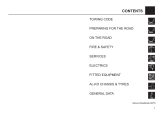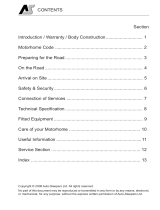
Owner’s Manual 2
Table of Contents
For dened warranty terms, please see the one page warranty statement included in the product information packet.
Safety Awareness ................................................................................................................................................................................. 2
Safety Instructions ................................................................................................................................................................................3
About Your Refrigerator ........................................................................................................................................................................4
Storage volume .............................................................................................................................................................................4
Leveling .........................................................................................................................................................................................4
Operation during travel .................................................................................................................................................................. 4
Food compartment ........................................................................................................................................................................4
Crispers .........................................................................................................................................................................................4
Door bins .......................................................................................................................................................................................4
Adjustable shelves ........................................................................................................................................................................5
Freezer compartment ....................................................................................................................................................................5
Door handles .................................................................................................................................................................................5
Temperature switch monitor ..........................................................................................................................................................5
Operating the Refrigerator Controls .....................................................................................................................................................6
Control Panel.................................................................................................................................................................................6
Ignition - LP gas operation ............................................................................................................................................................7
Do a test of the LP gas safety valve .............................................................................................................................................. 7
Start up - AC operation ..................................................................................................................................................................7
Start up - DC operation .................................................................................................................................................................7
Shut down .....................................................................................................................................................................................7
DC Operation Precautions ............................................................................................................................................................8
DC Operation Guidelines ..............................................................................................................................................................8
Effects of High Altitude on LP Gas Operation .......................................................................................................................................8
Effects of Freezing Temperatures on Refrigerator Operation ............................................................................................................... 8
Refrigerator Care Checklist ..................................................................................................................................................................9
Defrosting .............................................................................................................................................................................................9
Cleaning .............................................................................................................................................................................................10
Drip tray ....................................................................................................................................................................................... 10
Door Sealing ....................................................................................................................................................................................... 10
Refrigerator Maintenance Checklist ................................................................................................................................................... 11
Refrigerator Storage ........................................................................................................................................................................... 11
Refrigerator Maintenance ...................................................................................................................................................................12
LP gas ame appearance ...........................................................................................................................................................12
Remove and clean the burner orice ..........................................................................................................................................12
Remove the Refrigerator ....................................................................................................................................................................13
Reinstall the Refrigerator .................................................................................................................................................................... 14
Replacement Parts .............................................................................................................................................................................14
Wiring Pictorial....................................................................................................................................................................................15
Wiring Diagram ................................................................................................................................................................................... 16
Read this manual carefully and understand the contents before you use the refrigerator.
Be aware of possible safety hazards when you see the safety alert symbol on the refrigerator and in this manual. A signal word follows
the safety alert symbol and identies the danger of the hazard. Carefully read the descriptions of these signal words to fully know their
meanings. They are for your safety.
This signal word means a hazard, which if ignored, can cause dangerous personal injury, death, or much
property damage.
This signal word means a hazard, which if ignored, can cause small personal injury or much property
damage.
Safety Awareness
CAUTION
!
WARNING
!



















